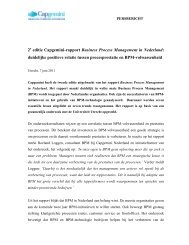IT transformations - Capgemini Consulting Nederland
IT transformations - Capgemini Consulting Nederland
IT transformations - Capgemini Consulting Nederland
You also want an ePaper? Increase the reach of your titles
YUMPU automatically turns print PDFs into web optimized ePapers that Google loves.
significant changes to traditional<br />
consumption patterns. The popularity<br />
of web services is eating into<br />
traditional telco revenue streams.<br />
At the same time, telco pricing<br />
models to monetize such traffic do<br />
not appear to be working. Moreover,<br />
with large social networking sites<br />
such as Facebook erecting what is, in<br />
essence, a massive walled garden with<br />
extensive communication features, the<br />
telco’s ability to monetize significantly<br />
diminishes.<br />
Emerging Opportunities in New<br />
Sectors<br />
The widespread deployments of<br />
wireless networks, coupled with an<br />
increased appreciation of the value<br />
of connectivity, have meant that<br />
opportunities for telcos have opened<br />
up in new sectors. Multiple operators<br />
are actively looking at opportunities<br />
in sectors such as healthcare,<br />
automotive, energy, and utilities. BT<br />
has ventured into the smart metering<br />
area by setting up an alliance with<br />
two other companies under the brand<br />
name SmartReach 4 . However, a move<br />
into these new sectors also means<br />
that telcos will have to change their<br />
traditional ways of doing business to<br />
be in line with the requirements of<br />
the new sector. Since opportunities<br />
span sectors, the key focus for telcos<br />
is to ensure that they have a model<br />
that they can deploy flexibly in other<br />
sectors.<br />
These factors are forcing telcos to<br />
innovate their business models. In<br />
this article, we analyze the evolution<br />
and current trends impacting<br />
business models and how telcos<br />
could potentially address the need to<br />
innovate their traditional models.<br />
Business Models and their<br />
Evolution<br />
Companies that want to be successful<br />
in the current environment have<br />
to fundamentally scrutinize their<br />
business model on a regular basis and<br />
challenge its components if necessary.<br />
Figure 1:<br />
Framework of a typical Business Model<br />
TARGET INTERACTION CREATION<br />
Markets<br />
Customer Segments<br />
Defined Product /<br />
Service Range<br />
VALUE<br />
PROPOS<strong>IT</strong>ION<br />
Source: <strong>Capgemini</strong> analysis<br />
However, in order to redefine its<br />
general orientation, it is critical to<br />
first understand the constituents of a<br />
business model.<br />
Structure of a Business Model<br />
The overarching goal of a business<br />
model is to address a business<br />
opportunity in such a way that value<br />
is created for customers as well as<br />
for the company. A business model<br />
encompasses the addressed value<br />
potential, the customer interaction,<br />
as well as the value creation model.<br />
A business model consists of three<br />
strongly interlinked dimensions:<br />
Target, Interaction, and Creation<br />
(see Figure 1).<br />
Target involves defining the revenue<br />
potential. This is derived as a sum<br />
of three key elements. First, the<br />
geographical or vertical markets<br />
within which the company is aiming<br />
to deliver the service. Second,<br />
the customer segments that are<br />
to be addressed and their specific<br />
requirements. And, third, a clearly<br />
defined product/service range offered<br />
based on previously identified<br />
customer requirements. These<br />
elements together form the basis for<br />
creating a unique value proposition<br />
for the company’s product/service.<br />
Customer<br />
Relationship<br />
Distribution Channels<br />
Payment Structure<br />
REVENUE<br />
MODEL<br />
Core Assets<br />
Core Processes<br />
Role of Partnerships<br />
COST BASE<br />
“<br />
A<br />
business model<br />
encompasses<br />
the addressed<br />
value potential,<br />
the customer<br />
interaction<br />
as well as the<br />
value creation<br />
model<br />
”<br />
4 ZDNET, British Gas, BT Push Ahead with Smart Meter Plans, October 2010.<br />
77
















